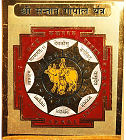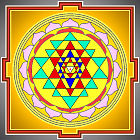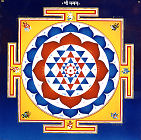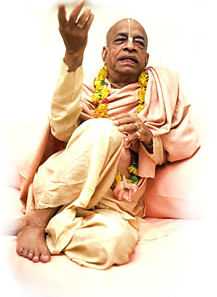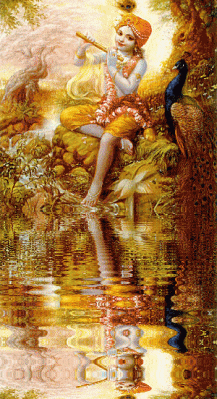![]() Śrī Gurv-aṣṭaka - Gebete an den spirituellen Meister
Śrī Gurv-aṣṭaka - Gebete an den spirituellen Meister
![]() Nitai-pada-kamala - Sri Nityanandas Lotusfüße
Nitai-pada-kamala - Sri Nityanandas Lotusfüße
![]() The 108 auspicious Names of Lord Śiva
The 108 auspicious Names of Lord Śiva ![]()
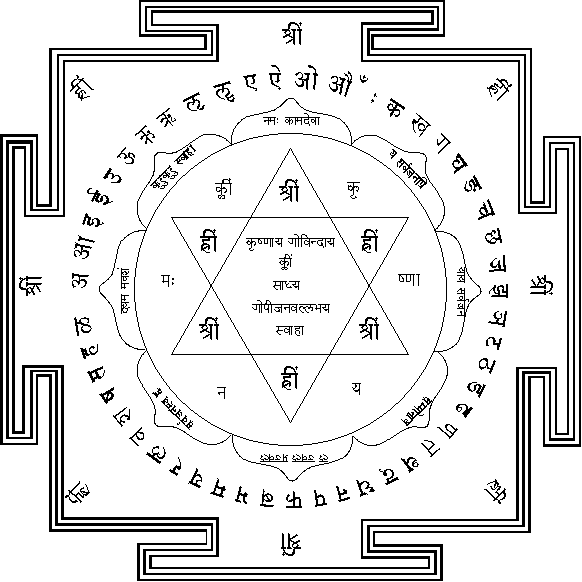
Gopala - Krishna - Yantra
Klīḿ Kṛṣṇāya Govindāya Gopījana-Vallabhāya Svāhā
In the hexagon in the centre of the yantra, the following words appear:
Klīḿ Kṛṣṇāya Govindāya Gopījana-Vallabhāya Svāhā. In the corners of the hexagon are the bija mantras Hrim and Shrim. Outside the hexagon is the Krishna mantra which runs: Klīṁ Kṛṣṇāya Namaḥ. In the petals of the yantra is a longer mantra: namaḥ kāmadevāya sarva-jana-priyāya sarva-jana-sammohanāya jvala jvala prajvala sarva-janasya hṛdayaṁ mama vamśam kuru kuru svāhā. Around the eight petals are the Matrikas or letters of the Sanskrit alphabet while in the angles of the protecting wall are bija mantras Hrim and Shrim, once more.
Śrī Brahma-saḿhitā 5.3 - The whorl of that transcendental lotus is the realm wherein dwells Kṛṣṇa. It is a hexagonal figure, the abode of the indwelling predominated and predominating aspect of the Absolute. Like a diamond the central supporting figure of self-luminous Kṛṣṇa stands as the transcendental source of all potencies. The holy name consisting of eighteen transcendental letters is manifested in a hexagonal figure with sixfold divisions.
PURPORT: The
transcendental pastimes of Kṛṣṇa are twofold, viz., manifested and
nonmanifested. The pastimes in Vṛndāvana visible to mortal eyes are
the manifestive līlā of Śrī Kṛṣṇa, and that which is not so visible,
is nonmanifestive līlā of Kṛṣṇa. The nonmanifestive līlā is always
visible in Goloka and the same is visible to human eyes in Gokula, if
Kṛṣṇa so desires. In his Kṛṣṇa-sandarbha Śrī Jīva Gosvāmī Prabhu
says, "Nonmanifestive pastimes are expressed in manifestive
kṛṣṇa-līlā. and goloka-līlā is the nonmanifestive pastimes of
Kṛṣṇa visualized from the mundane plane." This is also corroborated
by Śrī Rūpa in his Bhāgavatāmṛta. The progressive transcendental
manifestation of Gokula is Goloka. So Goloka is the selfsame majestic
manifestation of Gokula. The eternal pastimes of Śrī Kṛṣṇa, although
not visible in Gokula, are eternally manifested in Goloka. Goloka is
the transcendental majestic manifestation of Gokula. The manifestations
of the nonmanifestive pastimes of Kṛṣṇa with regard to the
conditioned souls, are twofold, viz., (1) worship through the channel
of the mantras (inaudibly recited, liberating, self-dedicatory.
transcendental sounds), (2) spontaneous outflow of heart's spiritual
love for Kṛṣṇa. Śrī Jīva Gosvāmī has said that worship through the
mantra is possible permanently in the proper place, when confined to
one pastime. This meditative manifestation of Goloka is the pastime
attended with the worship of Kṛṣṇa through the mantra. Again, the
pastimes that are performed in different planes and in different moods,
are autocratic in diverse ways; hence svā-rasikī, i.e., spontaneous,
outflow of heart's spiritual love for Kṛṣṇa. This śloka conveys a
twofold meaning. One meaning is that in the pastime attended with
worship through the mantra consisting of eighteen transcendental
letters, transcendental words contained in the said mantra being
differently placed make a manifestation of only one līlā of Śrī
Kṛṣṇa. As for example klīḿ kṛṣṇāya govindāya gopījana-vallabhāya
svāhā — this is a hexagonal mantra consisting of six transcendental
words, viz., (1) kṛṣṇāya, (2) govindāya, (3) gopījana, (4)
vallabhāya, (5) svā, (6) hā. These six transcendental words, when
placed juxtapositionally, indicate the mantra.
The hexagonal
great transcendental machinery is in this wise. The principal seed,
i.e. klīḿ, is situated in the instrument as the central pivot. Anybody
with an impression of such an instrument in his mind and concentrating
his thought on such spiritual entities, can attain, like Candradhvaja,
to the knowledge of the cognitive principle. The word svā indicates
kṣetrajña i.e., one who is conversant with one's inner self, and the
word hā indicates the transcendental nature. This meaning of the mantra
has also been corroborated by Śrī Hari-bhakti-vilāsa. The general
meaning is this that one who is desirous of entering into the esoteric
pastimes of Kṛṣṇa will have to practice His transcendental service
along with the culture of the devotional knowledge relative to Him. (1)
kṛṣṇa-svarūpa — the proper Self of Kṛṣṇa; (2) kṛṣṇasya
cin-maya-vraja-līlā-vilāsa-svarūpa — the true nature of Kṛṣṇa's
transcendental pastimes in Vraja; (3) tat-parikara-gopījana-svarūpa —
the true nature of His spiritual associates in Vraja, viz., the
spiritual milkmen and the milkmaids; (4) tad-vallabha — the true nature
of self-surrender to Kṛṣṇa in the footsteps of the spiritual
milkmaids of Vraja; (5) śuddha-jīvasya cid-(jñāna)-svarūpa — the true
nature of the spiritual knowledge of the unalloyed individual soul; (6)
cit-prakṛtir arthāt kṛṣṇa-sevā-svabhāva — the true nature of
transcendental service to Kṛṣṇa is this that the esoteric relation
is established on the awakening of one's pure cognition. The meaning is
that rasa is only the transcendental service of the central refuge Śrī
Kṛṣṇa, as predominating aspect of the Absolute, by one's ego as the
spiritual maid of the predominated moiety of the absolute integer,
attended with pure devotion in the shape of one's entire
self-surrender. The pastime in Goloka or in Gokula during the stage of
devotional progress, is the meditative worship through the mantra, and
during the stage of perfection the pastimes manifest themselves as the
unrestrained transcendental jubilations. This is the real aspect of
Goloka or Gokula, which will be made more explicit in due course. The
meaning of the words jyotī-rūpeṇa manunā [Bs 5.3] is that the
transcendental meaning is expressed in the mantra by means of which, on
transcendental desire of love for Kṛṣṇa and the service of Kṛṣṇa
being added, one is established in the eternal love of Kṛṣṇa. Such
eternal pastimes are eternally manifested in Goloka.
Śrī Brahma-saḿhitā 5.4 - The
whorl of that eternal realm Gokula is the hexagonal abode of Kṛṣṇa.
Its petals are the abodes of gopīs who are part and parcel of Kṛṣṇa
to whom they are most lovingly devoted and are similar in essence. The
petals shine beautifully like so many walls. The extended leaves of
that lotus are the gardenlike dhāma, i.e. spiritual abode of Śrī
Rādhikā, the most beloved of Kṛṣṇa.
PURPORT: The
transcendental Gokula is shaped like the lotus. The eternal world is
like a hexagonal figure; in that the entities Śrī Rādhā-Kṛṣṇa,
appearing in the form of a mantra consisting of eighteen transcendental
letters, are centered. The propagating manifestations emanating from
the cit potency are present there with the said entities as the center.
Śrī Rādhā-Kṛṣṇa is the primary cause or the seed Himself.
Gopāla-tāpanī says, "Oḿkāra" signifies the All-Powerful Gopāla and His
potency; and "klīḿ" is the same as oḿkāra. Hence kāma-bīja or the
primary cause of all-love, is connotative of the entities Śrī
Rādhā-Kṛṣṇa. ((Sri-Brahma-samhita))
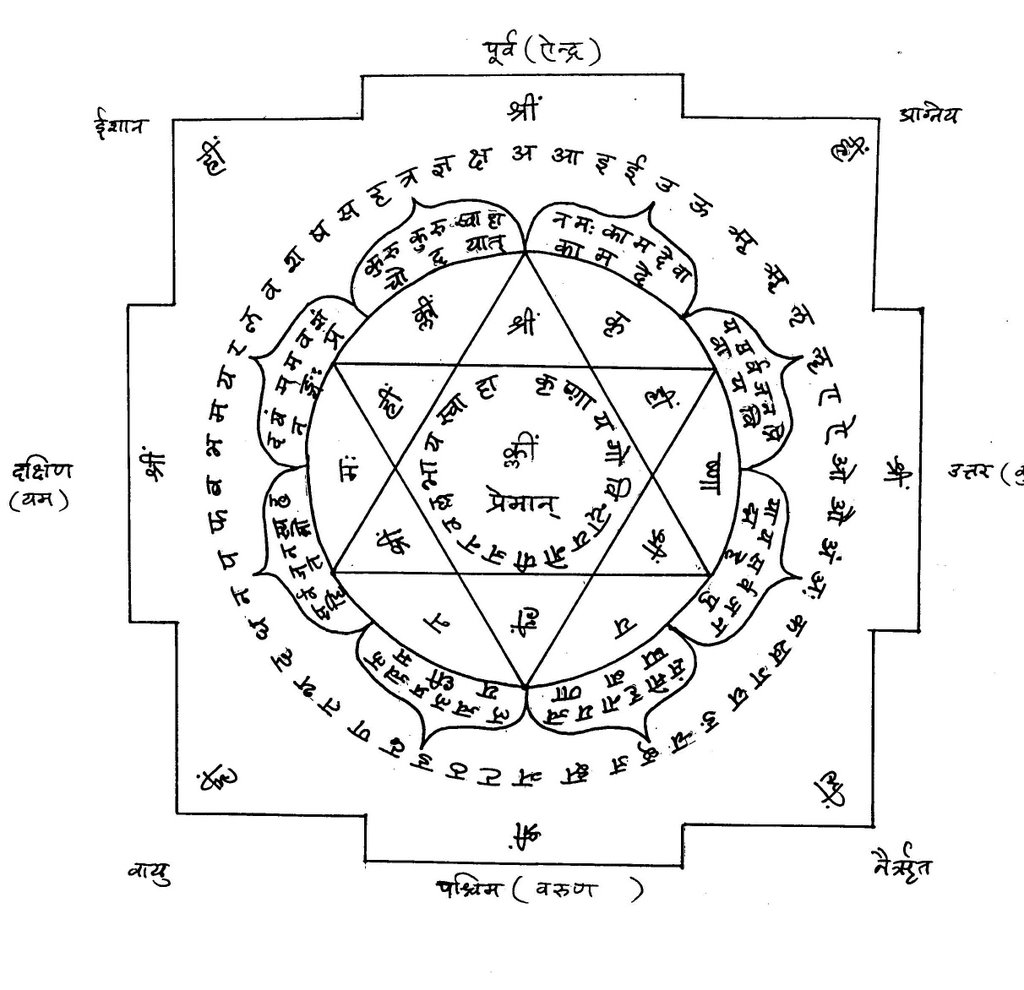
क्लीं कृष्णाय गोविन्दाय गोपीजनवल्लभाय स्वाहा
Klīḿ Kṛṣṇāya Govindāya GopījanaVallabhāya Svāhā
12. By chanting these five names one attains the Supreme Personality of Godhead, whose potencies are manifested as the heavenly planets, the earth, sun, moon, and fire.
13. A person who even once chants the mantra “Klim krsnaya govindaya gopijanavallabha svaha” quickly attains the association of Lord Krishna. He does not attain any other result. (Gopala-Tapaniya Upanishad)
Architectonics of Śrī Gopāla Yantra
By Balarāma Dāsa
Gopāla is an epithet of Kṛṣṇa in the form of a young cowherd boy in Vṛndāvana.
Yantra - consists of the root yam - "to sustain, control or hold". Meanings for the noun derived from this root include:
• "any instrument or machine" (i.e. that which is controlled or controls. For instance the body is said to be a yantra)
• "any instrument for holding, restraining, or fastening" (for instance a symbol which 'holds' the essence of a concept, or helps the mind to 'fasten' on a particular idea)
• "a mystical or astronomical diagram" (usually a symbol, often inscribed on an amulet) sometimes said to possess mystical or magical powers.
tra - is an Indo-European suffix meaning ' instrument', found in Latin 'aratrum' and in mantra and tantra, hence a literal translation would be "instrument to control".
The configurative architectonics of Śrī Gopāla Yantra is delineated in the concluding portion of the seventeenth chapter of Śrī Hari-bhakti-vilāsa titled "Pauraścaraṇikaḥ"
atha yantram
(Deliberation on Yantra)
sanat-kumāra-kalpe–
(in the Sanat-kumāra-kalpa it is stated)
arcanārthe mune vakṣye yantraṁ śrī-karam uttamam |
sva-gṛhe vā vane cātha viṣṇor āyatane’thavā ||261||
O' Sage, I shall now describe to you the understanding of a yantra, which when worshiped awards wealth to the worshiper. First, one should settle on a place in his house or in the forest, or a secluded space within a temple of the Supreme Lord.
sthānam ekāntam āśritya śodhayed gomayāmbhasā |
tatra saṁsthāpayet pīṭhaṁ kṣālitaṁ śuddha-vairiṇā ||262||
This place should be cleansed with cow dung and pure water. After cleansing, one should be cleaned with cow dung and pure water. After cleansing, one should construct a platform there.
vilikhya gandha-paṅkena likhed aṣṭa-dalāmbujam |
karṇikāyāṁ likhed vahni-puṭitaṁ maṇḍala-dvayam ||263||
One should draw on the platform with sandalwood paste a lotus flower having eight petals. Then, within the whorl of that lotus, one should draw triangles forming a hexagon.
tasya madhye likhed bījaṁ sādhyākhyaṁ karma-saṁyutam |
tataḥ śiṣṭair manor varṇais taṁ kāmaṁ veṣṭayet sudhīḥ ||264||
In the middle of the hexagon, an intelligent devotee should write the kāma-bījākṣara, along with his personal ambition. One should also write “klīṁ kṛṣṇāya namah”. Then a learned scholar should surround the kāma-bījākṣara with the other seventeen syllables of the eighteen-syllable mantra.
śriyaṁ ṣaṭ-koṇa-koṇeṣv aindra-nairṛta-vāyuṣu |
ālikhya ca likhen māyāṁ vahni-vāruṇa-śūliṣu ||265||
One should write the śri-bījākṣara on the eastern, south-western, and north-eastern sides of the yantra, and he should write the māyā-bījākṣara in the south-eastern, western, and north-eastern sides[i] .
mantraṁ ṣaḍ-akṣaraṁ tatra vilikhet ṣaṭsu sandhiṣu |
akṣaraiḥ kāma-gāyatryā veṣṭayet keśare sudhīḥ ||266||
One should write the six-syllable kṛṣṇa mantra on the six joints of the yantra. The syllabic letters of kāma-gāyatrī mantra should be written around the petals of the lotus.
kāma-mālā-manor varṇair daleṣv aṣṭasu mantra-vit |
likhed guhānanair bhaktair māntrikāṁs tad-bahir likhet ||267||
Using nicely prepared homemade ink, a learned devotee should write the forty-eight-syllable kāma-mālā-mantra on the eight petals of the lotus so that each petal has six letters. Outside the lotus, one should write the fifty-one, mātṛkā varṇā.
bhū-bimbaṁ ca likhed bāhye śrī-māyāṁ dig-vidiksu ca |
evaṁ yantraṁ samālikhya jāta-rūpa-maye paṭe ||268||
Outside these mātṛkā varṇā, one should draw a bhūpura-maṇḍala. Outside the bhupura -maṇḍala, one should write Bījā akṣara Śrīṃ̇ in the four directions, beginning with the east, and outside that, one should write Hṛīṁ in the four corners, beginning with the north-east. Outside Śrīṃ̇, one should also draw a symbol representing a vajra.
rājate tāmra-paṭṭe vā bhūrje kṣauma-maye’pi vā |
sūkṣma-tantu-paṭe vāpi pratiṣṭhāpya samīraṇam ||269||
After preparing the Yantra by writing on silver, copper, gold plate or leaf, one should invoke life into the Yantra by chanting the appropriate mantra.
hutvā sahasram ājyena yantre sampātapūrvakam |
arcayitvāyutaṁ japtvā dhārayed yantram uttamam ||270||
Thereafter, he should perform a fire sacrifice by offering one thousand oblations of ghee. Then, he should worship the yantra and chant his mantra ten thousand times as japa. After completing the ritual, one should wear the potent yantra.
trailokyaiśvaryam āpnoti devair api supūjitaḥ |
ākarṣaṇaṁ sura-strīṇāṁ nāga-loka-nivāsinām ||271||
By wearing this yantra, one achieves all the opulence of the three worlds and is venerated by the demigods. The consorts of devas and nāgas become attracted to one who wears this yantra.
piśācayakṣa-rakṣāṁsi krūra-bhūta-gaṇāś ca ye |
duṣṭa-sarpādayaḥ sattvā hy apasarpanti dūrataḥ ||272||
Yakśa , Rākśasa (demon), Bhūta (ghost), hobgoblins, wild animals, and serpents run away to a great distance from one who wears this Yantra.
antra-rāja-dharaṁ dṛṣṭvā vidravanti ca bibhyati |
bahunā kiṁ ihoktena sarva-loka-sukhāvaham ||273||
Miscreants run away in fear when they see someone wearing this king of Yantras. Everyone becomes happy by the influence of this Yantra and so, what more can I say?
strīṇām ākarṣaṇaṁ sadyo rājñāṁ vaśyakaraṁ bhuvi |
yoga-siddhi-karaṁ puṁsāṁ bhava-sāgara-tārakam |
bhukti-mukti-pradaṁ divyam iti proktaṁ ca vedhasā ||274||
This Yantra attracts all kinds of females, keeps the rulers of men under control, awards mystic perfection to great yogis, delivers one from the ocean of material existence, awards on material enjoyment and liberation and ultimately enables one to return to the transcendental abode of the Lord, Śrī Vaikunṭḥalokas. This is confirmed by Brahma.
________________________
[i] The eight directions are East (Indra) at 0o, SE (Agni) at 45o, S (Yama) at 90o, SW (Nairāta) at 135o, W (Varuṇa) at 180o, NW (Vāyu) at 225o, N (Kubera) at 270o, NE (Īṣāna) at 315o.
Download PDF
Gopala-Tapaniya Upanishad
By Tripurari Swami
Free English Translation
